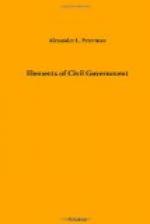School government, while partaking of the nature of civil government, is still more closely allied to family government. In the natural state, and in the isolated household, the education of the child devolves upon the parents, and the parent delegates a part of his natural rights and duties to the teacher when he commits the education of his child to the common school. The teacher is said to stand in loco parentis (in the place of the parent), and from this direction, mainly, are his rights of government derived. The school, therefore, stands in an intermediate position between family government and civil government proper, partaking of some features of each, and forming a sort of stepping-stone for the child from the natural restraints of home to the more complex demands of civil society. The school district, also, while partaking of the nature of a civil institution, is in many respects to be regarded as a co-operative organization of the families of the neighborhood for the education of their children, and its government as a co-operative family government.
THE CIVIL UNIT DEFINED.
In nearly every part of the United States there is a unit of civil society in which the people exercise many of the powers of government at first hand. This civil unit is variously named in the different States, and its first organization may have been for some minor purpose; but it has grown to be an important sphere of government in many States, and throughout the entire country it is the primary school of the citizen and the voter.
There are many different names by which this civil unit is known.
In the State of Mississippi it is called the Beat, and this name is no doubt derived from the original purpose of the organization, as the jurisdiction of a watchman or constable.
In Delaware it is called the Hundred, which is the old English subdivision of a county, supposed to contain one hundred families, or one hundred men able to bear arms in the public service.
In the New England States, in New York, and in Wisconsin it is called the Town, from the old Anglo-Saxon civil unit, which antedates the settlement of England by its Saxon invaders, and is probably older than the Christian era.
In Arkansas, Indiana, Iowa, Kansas, Michigan, Minnesota, Missouri, Montana, New Jersey, the Carolinas, Ohio, Pennsylvania, and parts of Illinois, Nebraska, and the Dakotas, it is called the Township, only a variation of name from the “town,” and having the same origin.
In California it is called the Judicial Township, and in parts of the Dakotas it is called the School Township.
In Alabama, Colorado, Florida, Idaho, Oregon, Utah, Washington, and parts of Illinois and Nebraska, it is called the Election Precinct, from the fact that it was the subdivision made for the convenience of voters.




